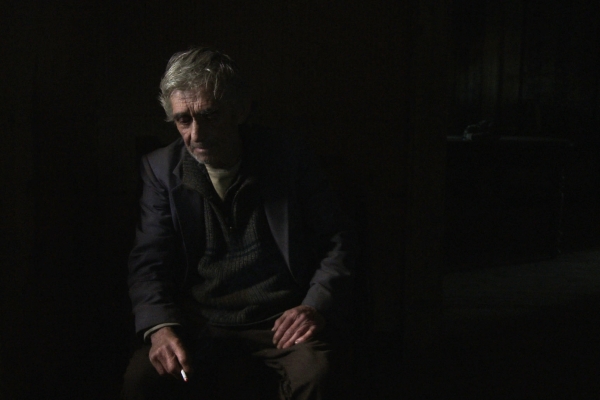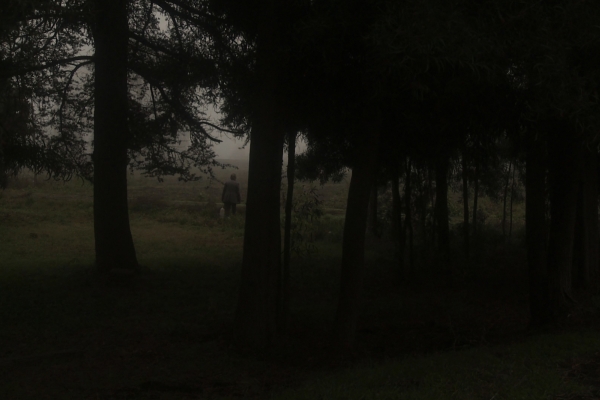Twilight Zone
To start the New Year, the Museum introduces First Look, a new annual showcase curated by Dennis Lim, Rachael Rakes, and David Schwartz. This two-weekend program—which brings together some of the most invigorating and inventive voices in contemporary world cinema, including established and emerging filmmakers—affirms our belief in cinema as a flourishing art form. To supplement the program, Moving Image Source is running a series of essays on all the feature films that are being shown. Check back daily from now through next weekend for new articles.
Much like the global "slow food" movement, what could be termed a global "slow cinema" movement has steadily—slowly?—grown over the past decade-plus. Yet like the tradition of preparing whole foods patiently and lovingly, the practice of slow films has long been with us: Michelangelo Antonioni stirred a stodgy Cannes audience into a near-riotous mood when L'avventura, with its attenuated longueurs and gazes, premiered in 1960, and soon after, Andy Warhol made the day-long Empire as an experience in watching in real, yet elongated time. What's changed of late are the conditions. Just as the intensity and mass-marketing of fast food produced a slow-food counterculture that stretches from Berkeley to Umbria, the saturation in pop culture of increasingly faster images—a by-product of MTV music videos and video games—has made slow cinema a kind of counterculture of its own, a space that allows for radical notions of temporality, for questioning dominant cinema's oppressive insistence on speed as the only viable tempo. Part of the excitement when audiences began to discover Béla Tarr in the mid-1990s with Damnation and especially his seven-and-a-half-hour Sátántangó was to encounter a filmmaker who deliberately altered one's body clock and mental rhythms, drawing down the sensory cadences in a similar way that composers Louis Andriessen (De Tijd) and Gavin Bryars (The Sinking of the Titanic) have stretched and elongated notes and time signatures.
The effect can be so total, as in Tarr, Antonioni, or Andriessen, as to make anything viewed and heard afterwards seem abnormally, even grotesquely, fast. But the best of the slow movies aren't slow for slowness's sake: a slow food chef will tell you that the graduated rhythms of cooking are always for the end object of tasting and eating food at its finest and fullest, where its complete potential has been realized. In one seminal example of the slow movie anchored to ideas in perfect orbit with the pace, Lisandro Alonso's La libertad achieves its full effect as an expression of work standing as a life purpose—the essential, existential meaning of work—by showing the work as it is. In this case, it's a lonely woodcutter making a living in the Argentine pampas brushlands, and that is the point: making a living. The pace is dictated less by the direction, editing, or mise-en-scène (though these are always at play) than by the action itself, which is permitted to function at its own pace, and not the pace of "movies." And only with an extensive and patient gaze by Alonso can the work be fully seen, heard, and absorbed as it really is; in this aesthetic framework, a cut becomes an extremely dramatic act, one not lightly judged.
A direct offspring of La libertad is Théo Court's extraordinary new film, Ocaso (a better title than its English title, Decline, which is all too emphatic and on-the-nose). The step-by-step, minute-by-minute, task-by-task routines of an elderly caretaker of a decaying Chilean estate form the core of Court's conception, but—like La libertad—Ocaso ventures far beyond the simple activities of a seemingly simple man, played with great stoicism by Rafael Vazquez, whose total absence of performing may lead viewers to mistake him as the actual caretaker and the film as an actual portrait. Ocaso is a fiction, but also a non-fiction, a blend of both, an in-between film. If this is your first in-between film, you're about to have a good introduction.

Ocaso
The old man is first seen walking toward the estate in a series of long shots, first in mist-laden fields, and then through the estate grounds, which resemble the once-elegant, smudged, and crumbling California ranchos. Vazquez settles into his room, goes about preparing a stove fire, collecting wood and water from a nearby creek, and warms up the estate's chilly interiors. Over the span of 25 minutes, Court and cinematographer Mauro Herce's camera (they can justifiably be viewed as co-filmmakers) doesn't merely observe Vazquez: the extended takes, allowed to play out in the manner of "documentary" real time, are meticulously composed with a highly sophisticated sense of framing and dimensionality, not just depth of field but weight of field, a framing of space as a by-product of history as represented by the old estate itself and its creaking, aching hallways and rooms, its interior and exterior skins peeling away. Crucially, the house is also being viewed as Vazquez's own, or, at least, that's the impression the viewer begins to form during the slow process of watching his slow process, the very fact of the slowness allowing for the impression to congeal into something approaching fact. But it's a fact that forms purely in our minds, since all that's in front of the camera is the old man and his domestic work. Court, however, is about to break up our sense of reality: at minute 26, another man, lying on a bed, stirs to life as Vazquez checks on him. He's not alone.
When a group of laborers arrives to work on house repairs and restorations, Vazquez suddenly is seen drifting to the frame's periphery and even, for some extended moments, disappearing into pure shadow. In a sense, he's ceding his position to their more important work, yet the workers remain offscreen, and even as a spectator taking in this new development in the matters of the estate, Vazquez remains central to Court's staging. Court and Herce sometimes directly quote from Vermeer, particularly in numerous shots in which the light source—limpid, all-enveloping of its human subject—is on the left side of the frame. In several exterior shots, the influence of Víctor Erice, one of the great slow cinema masters, can be lovingly felt, as when Vazquez climbs a ladder to pick fruit off a humble tree. The art-historical and cinematic references are there for those who wish to take them in, but the film never insists upon them; these are added layers to the fundamental matter at play here, the matter of a working man in the process of approaching his death.

Ocaso
Vazquez soon becomes audience to another spectacle, quietly listening as the other man, now wide awake and full of gab as he sits at a table near a window (always, always windows), announces that he's "been thinking about man's suffering" and of "a silence that is even bigger" than any man can conceive. This particular man, we're invited to infer, may be mad, for he considers himself without any visible justification, to be a "hero." But he hedges this: "I am a minor hero." The sentence hangs in the air for the rest of the film, and directly transfers its meaning to Vazquez's old caretaker; there's even a way in which the monologue by this odd figure—he may or may not be the estate's owner—actually comprises Vazquez's thoughts, disembodied. It also forms a break, for Vazquez immediately after leaves the estate and trudges down a highway on foot to his son's house, asking if he can room with him and get work.
The slowness of each scene, each movement, grows like tree rings, a solidity of time and deliberation, of thought. Vazquez does nothing without thought behind it, even as Court trains his fascination on him as an aging, slowed-down body, his formerly swarthy figure declining into a creaking, bony frame, a body willing itself to move forward as much as it possibly can. The sheer beauty of Ocaso can obscure these more disturbing physical realities, and here, too, Court is following in Alonso's path, while cutting out a fresh trail of his own. Both filmmakers embrace andante tempo for the purpose of, first, observation, then penetration, then completion. The old body lies down on the bed, and the shadows fall. And then the memory of the estate, perhaps not a memory but a dream lodged in the old man's fading mind, comes back one last time. ![]()
LATEST ARTICLES
-20140814-173707-thumb3.jpg)
Fighting Words
by Imogen Sara Smith
posted August 12, 2014

Fighting Words, Part 2
by Imogen Sara Smith
posted August 20, 2014

On the Margins: The Fil…
by Andrew Chan
posted August 12, 2014

Robin Williams: A Sense…
by David Schwartz
posted August 12, 2014
 Twilight Zone
Twilight Zone
RELATED ARTICLE
Unplugged by Phil ColdironIsland Time by R. Emmet Sweeney
Ghost World by Colin Beckett
Darkness Doubled by Leo Goldsmith
Jungle Fever by Andréa Picard
Going the Distance by Scott MacDonald
Glass Houses by Michael Sicinski
A Nude by Garrel by Eugenio Renzi
Family Viewing by Mark Peranson
Capitalist Punishment by Shelly Kraicer
Her Own Devices by Robert Koehler
The Fallen by Phil Coldiron
The 1 Percent Solution by Michael Sicinski
More: Article Archive
THE AUTHOR
Robert Koehler is a film critic contributing to Variety, Cinema Scope, Film Comment, Cineaste and Film Journey, and a festival programmer.
More articles by Robert Koehler
